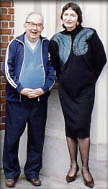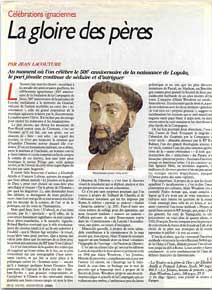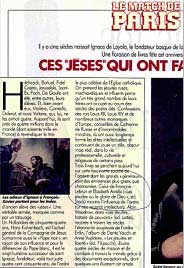|
Cocktail
 
With Jesuits at New-Orleans.
RESEARCH
Jesuits have been, in some way, present everywhere in my life. Some of my friends, even, suggest that it was not by chance that my first book was entitled « Ave Lucifer ». No kidding, I met them for the first time in 1975, when shooting a film for French TV, on the World Congregation of the Company of Jesus, The Black Council" , (Le Concile noir. Then, when I founded my own publishing company, Editions Antébi, I decided to write and produce the first illustrated book in the world which told the history of the Jesuits, from the beginning until the present day, and in all parts of the world – USA, Africa, India, China, and so on – with many unpublished or original photos and documents. I was greatly helped in this task by Father Calvez s.j ., as, if I dare to say, my own “grey eminency”, and with a board of pernickety advisors (Fathers Blet, Padberg, Ravier, Vandermeersh and O’Malley). Later, in 1999, I presented, near Rome, a CD-ROM, on Jesuit pedagogy throughout Europe, Roots for tomorrow, , in three languages.
Indeed, when I was shooting the film, I was surprised to see that no book had ever been published on the entire history of the Jesuits, especially after the suppression by the Pope, at the end of the XVIIIth century. No book either, on the geographical expansion of the Jesuits, from the Ancient to the New Worl. François Lebrun, a Ph.D. in History, and in French Literature and Classics, specialist in the History of Religions, wrote the first part – from the founding of the Order, until its suppression by Pope Clement XIV, in July 1773. I wrote the section on the period from the « suppression », to the revival (the restoration by Pope Pie VII, August 1814), bringing the history up to the present day.
The illustrations come from many archives (in the US, but also in Europe and Japan), from photos that I had taken myself, from photos in the private collections of Jesuits, showing Jesuit students acting in theatre (the role of Hecube or Athalie!) or playing sports, in India, in Australia and elsewhere.
SUMMARY
The Order of Jesus was founded in 1540 by Ignatius Loyola, a soldier who became a pilgrim, to carry out a (Counter-)Reform from within the Church, answering in that way the Protestant Reform. Its painters, architects, sculptors, astronomers, mathematicians, and humanists, have contributed to its success. Its confessors have influenced the kings, its preachers have influenced the crowds. Photos, engravings, watercolours, statues, stained-glass windows and unusual objects, bear witness to the process by which Jesuits from Macao to Washington, from India to Paraguay, have contributed to changing our way of looking at ourselves and the world around us. At the end of the book, Father John O’Malley, s.j., Professor of the History of the Church at Weston School of Theology (Cambridge, USA), concludes with an exploration of the modo nostro (“our way of proceeding”) or the Jesuit approach of the universe.
PRESS BOOK
 “Every once in a while I take out your volume on the Jesuits, and I marvel at how you did it single-handedly. As you may or may not know, I published a book on the Jesuits with Harvard University Press in 1963, and I have often intended to send you a copy. Your card has FINALLY prompted me to take action, and I will put one in the mail (surface) to you this afternoon. Please accept it as a token of admiration and appreciation.” Father John O’ Malley, s.j., Weston Jesuit School of Theology, Cambridge, Massachusetts. “Every once in a while I take out your volume on the Jesuits, and I marvel at how you did it single-handedly. As you may or may not know, I published a book on the Jesuits with Harvard University Press in 1963, and I have often intended to send you a copy. Your card has FINALLY prompted me to take action, and I will put one in the mail (surface) to you this afternoon. Please accept it as a token of admiration and appreciation.” Father John O’ Malley, s.j., Weston Jesuit School of Theology, Cambridge, Massachusetts.
« Elizabeth Antébi and François Lebrun, authors of this magnificent coffee-table book Les Jésuites ou la Gloire de Dieu, could have been even more audacious, writing a sub-title « or the Glory of Man » :This is, indeed, the big difference between the Order and its predecessors: without hiding their ultimate goals, the Jesuits were often the best at using science, art, and politics, in the pursuit of Humanism. But what a beautiful book! First – and that’s typically Jesuit – offering a ‘visual presentation’, from the jacket, showing two father-mandarins, to the last vignette. Roland Barthes once said that the revolutionary role of the Jesuits was the substitution of the aural message – which the Middle Age had always regarded as sacred – with the visual, hitherto believed to be a source of perversion. Who could have defended this thesis better than the authors of this book, with the very official backing of Father Jean-Yves Calvez? The texts are very well written, but above all, the imagination is caught by the images – an impressive number of very interesting and expressive images and caricatures. From the screens, dating from the Kano Period, to the paintings of Castiglione “the Chinese”, from the Guarani Christs to rococo pomp – presented here under the title « Mastery of illusion » -, we are treated to an entire visual discourse of Jesuitism . . , analyzed and presented with perspective and great talent.» Jean Lacouture, Le Nouvel Observateur.
 «Hitchcock, Buñuel, Fidel Castro, Jaruzelski, Saint-Ex, Foch, De Gaulle, among others, have been students of the Jesuits. And, before them, Molière, Corneille, Diderot and even Voltaire who didn’t like them. Today, around 4 million people in the world (60 000 of whom live in France) claim to be Jesuit alumni. This book by François Lebrun and Elizabeth Antébi shows the broad extent of the influence of the Order on our way of thinking » Paris-Match. «Hitchcock, Buñuel, Fidel Castro, Jaruzelski, Saint-Ex, Foch, De Gaulle, among others, have been students of the Jesuits. And, before them, Molière, Corneille, Diderot and even Voltaire who didn’t like them. Today, around 4 million people in the world (60 000 of whom live in France) claim to be Jesuit alumni. This book by François Lebrun and Elizabeth Antébi shows the broad extent of the influence of the Order on our way of thinking » Paris-Match.
« A very clever popularization ». Gérard Moatti, L’Expansion.
« A great achievement and success in putting together erudite texts and brilliant images ». Notre Histoire.
« The Order is not only ‘described, but ‘shown’ as befits an organisation that, more than any other, has abolished the censure of what you can look at, in a Christian tradition which greatly favours aural perception, above the other senses – as Roland Barthes had once remarked in a book on Ignatius Loyola. To present the Order of Jesus as the ‘order of the view’ gives an opportunity to highlight the pomp of baroque ornamentation, with its aim of dazzling and attracting as many people as possible. And it’s precisely what the authors of this book on Jesuits have done, telling and showing that there is not one particular Jesuit style, but a Jesuit design of space, a taste for a ‘visual preaching’, of which the cartographers at the court of China and the founders of the ‘reductions’ of Paraguay remain the models. A magnificent book ». L’Histoire.
« This photo could have been taken by a Jesuit. It is by Cartier-Bresson. In black and white, with head raised and hands pressed together, five or six members of the Order of Jesus are frozen in contemplation. With humour, in fact, because this pious position is just in the eye of an ironical photographer : art lovers in cassock, the Jesuits, whose heads unwittingly rise out of the painted and unclothed body of a languorous young woman, are only looking at a painting, concealed from us, the readers. Optical illusion, false devotion… Jesuit humour is not just a tale. And these ‘world opticians’, with their incisive glance, have had no illusions for a very long time. For the greater Glory of God (ad majorem Dei Gloriam), they chose, like Saint Ignatius in 1540, to be part of the mundane world. Like chameleons, they are poor with the poor, Indian with the Indians. In their high schools or in the depths of Amazonia. They have always inspired the worst fantasies. ‘Secret Army’, ‘Soldiers of God’, they number today 25 000 throughout the world. Four hundred drawings, photos, reproductions of paintings and manuscripts retrace cleverly and in an original way, the history of that Order which has awoken through five centuries, more mistrust, suspicion and repression than real recognition and even gratitude. In two parts (The Period of the Missions, The Period of Immersion), Les Jésuites ou la Gloire de Dieu describes the journey of the disciples of Ignatius Loyola. […]At the heart of any culture, you can search every nook and cranny of modernity, and to find them, in that Jesuit kaleidoscope: a tag of Californian wine, an advertising folder for a high school for women specializing in Winners ( !); they appear in the Mannerist ceiling painting of the church of the Roman College or in the contemporary canvas of the Slovenian scholastic Marko Ivan Rupnik. ‘Our way of proceeding’, explains Father John O’Malley, s.j., professor of the History of the Church at the Weston School of Theology at Cambridge (USA), in the afterword, has never been a question of routine or some mechanical answer. Above all, it’s a dynamic. » And indeed, an enterprising spirit is directing this company of loners. » Jean-Michel Dumay, Le Monde, December 14, 1990.
« In 1965, there were, worldwide, 36 000 Jesuits. At the end of 1990, they are now 24 000.[…] The book by François Lebrun and Elizabeth Antébi describes the action of this “fighters for faith”. An invaluable retrospective » Alain de Penanster, Valeurs Actuelles, november 5, 1990.
« Theatre, music and sports in Jesuit high schools throughout the world, lunar eclipses observed by Jesuits in China, maps made by Jesuit geographers, paintings and sculptures by Jesuit artists from the Five continents – that’s the wonderful and unexpected iconography of this superb book (300 colour photos). The text explains in detail the controversies that erupted between the Jesuits and Pascal, and between the Jesuits and the philosopher of the Lights. For the conclusion, the authors step aside to let Father John O’Malley, Jesuit theologian, explain the modo nostro, “our way of proceeding”. » Lu, November 1990.
« A very clever and beautiful work. From the Pilgrim to the new « General », Father Kolvenbach, the amazing Epoch of the Order of Jesus that has taught the youth, confessed the kings and never forgotten the poor.. . » L’Express, december 21, 1990.
«Everything (there is to know) about Jesuits. Funny, moving, surprising, skilful, probably exhaustive. » Minute.
«An excellent and beautiful history book ». La Vie.
What the Jesuits have written :
« The book has just arrived and is magnificent! I have shown it immediately to Father Kolvenbach. Bravo for this huge work and realisation.» Father John J. O’Callaghan, s.j., head of the Curia of the General Officer of the Order of Jesus.
« I am thrilled to receive the book, and even more with its content, art design and presentation. You can, on more than one count, feel proud and happy, and I wish you the success that your work merits. […] I have been delighted to help you in your research and even more delighted to see the result of your enthusiasm.» Father John W. Padberg, s.j., head of The Institute of the Jesuit Sources, St Louis.
EXTRACTS
In the Process of Translation
Pierre angulaire de la Réforme catholique, le concile de trente, qui s’est réuni à plusieurs reprises à partir de 1545 et qui a achevé ses travaux en 1563, ne reconnaît officiellement, en ce qui concerne la vie religieuse des femmes, que les ordres de vie monastique. D’où les difficultés qu’allaient rencontrer celles qui concevaient un « apostolat hors les murs » et qui choisiraient de s’inspirer de la spiritualité ignatienne. Très tôt cependant, saint François de Sales, fondateur avec Jeanne Frémyot de Chantal, de l’ordre de la Visitation en 1610, et saint Vincent de Paul, fondateur des Lazaristes en 1625 et des Filles de la Charité, avec Louis de Marillac, tentent d’élaborer des structures nouvelles permettant aux femmes d’allier la contemplation au service apostolique. Tous deux seront obligés de se plier aux idées du temps et de choisir entre les deux modes d’action, le premier retirant les Visitandines du service des pauvres et les enfermant dans un cloître (ce qui était en réalité leur vocation première), le second, à l’inverse, renonçant au titre de religieuses pour les Filles de la Charité. Dans ce contexte, on peut comprendre le courage qu’il fallut à une femme comme Maria Ward pour s’obstiner dans une voix « scandaleuse » aux yeux du monde et de l’Eglise, et la force qu’elle mit en œuvre pour arriver à convaincre le pape de les protéger, elle et ses compagnes. On peut aussi comprendre de quelle nécessité fut l’appui des gens haut placés à la Cour ou à Rome, la méfiance et l’isolement qui frappèrent la plupart des fondatrices de ces compagnies d’un nouveau style et l’extrême prudence des jésuites, directeurs de conscience des femmes de spiritualité ignatienne.
(à continuer)
|



